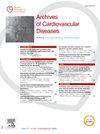Epicardial adipose tissue-derived mediators promote atrial endothelial dysfunction through pro-inflammatory cytokines and the AT1R/NADPH Oxidases/SGLT2 pathway
IF 2.3
3区 医学
Q2 CARDIAC & CARDIOVASCULAR SYSTEMS
引用次数: 0
Abstract
Introduction
Epicardial adipose tissue (EAT) is implicated in left atrial dysfunction via paracrine mechanisms, promoting endothelial dysfunction, pro-arrhythmogenic effects, and tissue remodeling, all of which favor the onset of atrial fibrillation (AF). Sodium-glucose co-transporter 2 inhibitors (SGLT2i) have recently been shown to reduce AF incidence, EAT volume, and inflammation, but the underlying mechanisms remain unclear.
Objective
This study explores the effects of human EAT-derived mediators on atrial endothelial cell (AEC) function and evaluates the role of SGLT2 inhibition using empagliflozin (EMPA).
Method
EAT and subcutaneous adipose tissue (SAT) samples were obtained from 70 cardiac patients at Strasbourg University Hospital. Conditioned media (CM) from these tissues were applied to AECs (24 h). Tissue histology was assessed using hematoxylin and eosin staining, while protein and mRNA expression, reactive oxygen species (ROS), nitric oxide (NO) production, and pro-inflammatory cytokines levels were analyzed through Western blot, RT-qPCR, fluorescence probes, and ELISA, respectively.
Results
Compared to SAT, EAT exhibited greater vascularization, increased infiltration of M1-like macrophages, and higher expression of pro-inflammatory cytokines (IL-1β, IL-6, TNF-α), endothelial cell markers (VCAM-1, eNOS), pro-fibrotic proteins (TGF-β), and pro-oxidant factors (NADPH oxidases NOX-1 and SGLT1/2). These changes correlated with elevated oxidative stress, mitigated by inhibitors targeting NOS, NADPH oxidases, ACE, AT1R, or SGLT2. Notably, SGLT2 and ROS levels in EAT were elevated in AF patients and increased with age. On the other hand, EAT-CM contained significantly higher concentrations of pro-inflammatory cytokines compared to SAT-CM. Exposure of AECs to highly inflamed EAT-CM (top quartile) induced oxidative stress, impaired NO production, upregulated p53 and SGLT2 expression, and triggered NF-κB nuclear translocation, whereas CM from less inflamed EAT didn’t induce these effects. EMPA prevented these effects.
Conclusion
In conclusion, EAT exhibits higher in situ expression and release of pro-inflammatory cytokines than SAT, contributing to oxidative stress via the AT1R/NADPH oxidases/SGLT2 pathway. Inflamed EAT-CM induces AEC dysfunction and activates NF-κB through cytokine-mediated oxidative stress and SGLT2 signaling. SGLT2 inhibitors may represent a promising strategy to reduce EAT inflammation and prevent cardiac remodeling and fibrosis.
心外膜脂肪组织源性介质通过促炎细胞因子和AT1R/NADPH氧化酶/SGLT2途径促进心房内皮功能障碍
心外膜脂肪组织(EAT)通过旁分泌机制参与左心房功能障碍,促进内皮功能障碍,促心律失常作用和组织重塑,所有这些都有利于心房颤动(AF)的发生。钠-葡萄糖共转运蛋白2抑制剂(SGLT2i)最近被证明可以降低AF发生率、EAT体积和炎症,但其潜在机制尚不清楚。目的探讨人eat源性介质对心房内皮细胞(AEC)功能的影响,并评价恩格列净(EMPA)抑制SGLT2的作用。方法采集斯特拉斯堡大学医院70例心脏病患者的皮下脂肪组织(SAT)和脂肪组织(deat)样本。将这些组织的条件培养基(CM)应用于AECs (24 h)。采用苏木精和伊红染色评估组织组织学,分别通过Western blot、RT-qPCR、荧光探针和ELISA分析蛋白和mRNA表达、活性氧(ROS)、一氧化氮(NO)产生和促炎细胞因子水平。结果与SAT相比,EAT表现出更大的血管化,m1样巨噬细胞的浸润增加,促炎细胞因子(IL-1β, IL-6, TNF-α),内皮细胞标志物(VCAM-1, eNOS),促纤维化蛋白(TGF-β)和促氧化因子(NADPH氧化酶NOX-1和SGLT1/2)的表达增加。这些变化与氧化应激升高相关,可通过靶向NOS、NADPH氧化酶、ACE、AT1R或SGLT2的抑制剂缓解。值得注意的是,在房颤患者中,EAT中的SGLT2和ROS水平升高,并随着年龄的增长而升高。另一方面,与SAT-CM相比,EAT-CM含有明显更高浓度的促炎细胞因子。aec暴露于高度炎症的EAT-CM(前四分之一)诱导氧化应激、一氧化氮生成受损、p53和SGLT2表达上调,并引发NF-κB核易位,而炎症程度较低的EAT的CM则不会诱导这些作用。EMPA阻止了这些影响。综上所述,EAT比SAT具有更高的促炎细胞因子的原位表达和释放,通过AT1R/NADPH氧化酶/SGLT2途径参与氧化应激。炎症性EAT-CM诱导AEC功能障碍,通过细胞因子介导的氧化应激和SGLT2信号激活NF-κB。SGLT2抑制剂可能是一种很有前途的策略,可以减少EAT炎症,防止心脏重塑和纤维化。
本文章由计算机程序翻译,如有差异,请以英文原文为准。
求助全文
约1分钟内获得全文
求助全文
来源期刊

Archives of Cardiovascular Diseases
医学-心血管系统
CiteScore
4.40
自引率
6.70%
发文量
87
审稿时长
34 days
期刊介绍:
The Journal publishes original peer-reviewed clinical and research articles, epidemiological studies, new methodological clinical approaches, review articles and editorials. Topics covered include coronary artery and valve diseases, interventional and pediatric cardiology, cardiovascular surgery, cardiomyopathy and heart failure, arrhythmias and stimulation, cardiovascular imaging, vascular medicine and hypertension, epidemiology and risk factors, and large multicenter studies. Archives of Cardiovascular Diseases also publishes abstracts of papers presented at the annual sessions of the Journées Européennes de la Société Française de Cardiologie and the guidelines edited by the French Society of Cardiology.
 求助内容:
求助内容: 应助结果提醒方式:
应助结果提醒方式:


